What is Phishing? A Look at One of Cybercrime’s Favorite Tactics
An in-depth look at the types of attacks that are involved in 32% of all
data breaches
In our news-heavy world, there isn’t a lot that surprises
us anymore. But there are a few questions we’re surprised to receive in our
technologically advanced era. One of the most critical of which is “what is
phishing?” It’s not always this exact question, however. Sometimes, it’s
one variety or another of the same question that’s just phrased differently,
such as “what does phishing mean?” “what is a phishing attack?” or “what is a
phishing email?”
Although these questions are commonly posed by random individuals
who come across our blogs, they’re sometimes posed by corporate executives — a
fact that is particularly worrisome for obvious reasons. After all, if an
organization’s leader lacks that necessary knowledge or cyber security
awareness, how can they expect their employees to be knowledgeable enough to avoid
the most common types of cyber attacks? Leaders need to lead by example, and
this means learning everything they can about these cyber threats.
Phishing is a very real and very dire threat to
organizations and individuals alike. In fact, in 2018 alone, nearly one-third
of all data breaches involved various types of phishing attacks or tactics.
We’re not just pulling this number out of a dark region; this
research comes from Verizon’s 2019 Data Breach Investigations Report. This
is just one of many reasons why phishing is so dangerous to businesses, brands,
employees, and consumers alike.
So, now, it’s time to break down the internet age old
questions, “what is phishing?” and “what makes phishing so effective?” We’ll cover
different types of phishing and will also dive into some of the ways to help
mitigate receiving phishing emails and how you can prevent your brand from
being used in phish that are sent to others.
Let’s hash it out.
Phishing Definition: What is Phishing, or What Does Phishing Mean?
Phishing is an overarching term for an entire category of
cybercrime against people and businesses alike that involve cyber fraud. Based
on the concept of fishing, phishing is a virtual form of hunting that involves
tricking users into “taking the bait” and getting hooked. The category of attacks
typically involves cybercriminals impersonating a person or organization and
using various tactics to extract information or compel the victim to perform a
particular action. The attacks can be made via email, over the phone, using
text messages or even social media
accounts.
At its core, phishing is a medium for an attack
but isn’t the weapon itself. These attacks often require you as the victim to do
something — click on a link, open an attachment, download a file, etc. These
actions typically will trigger the “payload” — the actual weapon of choice —
which often comes in the form of malware or ransomware. However, some
cybercriminals will instead drive you to a fake site that’s designed to look
like the real deal. There, you’ll be asked to update, change, or confirm
sensitive information like your account information and passwords.
Research from Duo shows that 62%
of simulated phishing campaigns capture at least one set of user
credentials. Considering that it only takes one set of credentials for
cybercriminals to break into your network, gain access to your databases,
access employee and customer data, etc., you can see why even one set of
credentials is such a major concern.
Phishing is about preying on the human element of
organizations and businesses. In their annual Human
Factor 2019 report, ProofPoint researchers indicate that “more than 99
percent of threats observed required human interaction to execute.” The study,
based on an analysis of 18 months of data, analyzed the company’s global
customer base. Less than one percent of the attacks targeted system
vulnerabilities.
Some more involved types of phishing involve weeks or
even months of pre-attack reconnaissance. This can involve cybercriminals using
malware, spyware, man-in-the-middle (MitM) attacks via unsecured Wi-Fi networks
to monitor or insert themselves in their target’s communications. They also
will often research the target online using websites such as Monster, LinkedIn, and
various social networking platforms.
An Example of Phishing in Action
But what does phishing look like? Let’s paint you a
not-so-pretty picture:
It’s a busy Friday afternoon in the accounts payable
department. Your employees are slammed with work when an email pops up from a
regular contact at one of your IT vendors. The subject line says it’s urgent:
There’s been a mix-up with a payment, and your organization’s account is
delinquent. The account needs to be brought current or else they’ll stop your
service, which will bring your company to a grinding halt. The body of the
email goes on to explain the dangers of further delinquency and encourages to
fix the situation ASAP. They also explain that their company recently updated
their account and they provide you with their new payment information.
For the sake of expediency, your employee uses the new
payment information the vendor provided to make the payment and continue on
with their day without another thought. What they don’t realize, however, is
that it wasn’t your vendor contact who sent you the email. It was a
cybercriminal pretending to be him. Fast forward a couple of months and your IT
vendor reaches out again. This time, however, they say that your account is
delinquent because they’ve not received payment in a few months. Thinking there
must be a mistake, your employee goes back to verify the account because they
know they’ve made the payment.
After some back-and-forth communications with the vendor,
your employee realizes that they’ve been scammed and have been making payments
to a fraudulent account. They come to you to find out what to do. You tell them
to halt any future payments to the fake account and to try to reverse any
previous payments, but it’s too late. The money — and the criminal — are now
gone, and your company is now out thousands or even millions of dollars.
We all know this scenario isn’t good for your
organization’s reputation. Nor is it good for job security. All you have to do
is look at the headlines from recent years to see the impact of successful
phishing attacks.
Spelling It Out: Why is Phishing So Effective?
A similar
scenario as the one we described above happened to Facebook and LinkedIn. A
Lithuanian hacker sent a series of fake invoices to both companies while
pretending to a tech vendor they both did business with. Both companies fell
for the scam, and their mistake them more than $100 million combined between
2013 and 2015. And they’re not alone — even local
governments throughout the U.S. have fallen for multiple phishing scams
this year (and over the past several years) that resulted in costly ransomware
attacks.
You may wonder how anyone can fall for such seemingly
simple tactics or obvious scams. But, remember: Phishing is about targeting
people in ways that catch them unawares. It’s about making convincing,
seemingly innocuous emails that convey a sense of urgency. This may involve contacting
the victim while impersonating someone they know — such as a friend, boss, or
vendor contact — or by simply using urgent language that spurs them to take
action now to avoid catastrophic consequences later.
ProofPoint’s Human Factor 2019 research:
“Instead of attacking
computer systems and infrastructure, threat actors focused on people, their
roles within an organization, the data to which they had access, and their
likelihood to “click here.” Whether attacking at a massive scale in large, indiscriminate
campaigns, going after specific industries or geographies with more targeted
campaigns, or seeking out a single person within an organization, attackers and
their sponsors consistently found human beings to be the most effective vectors
to infiltrate organizations and facilitate fraud and theft.”
So, why is phishing so effective? Phishing, in general,
is all about creating a sense of urgency, plausibility, and trust. So, what are
some of the factors that come into play when it comes to phishing?
- People are not infallible. Because your
employees are not perfect, they make mistakes. They rush, or they may simply be
unaware of certain dangers. Regardless of the reason, employees represent your
organization’s biggest attack vector or vulnerability when it comes to phishing
attacks. - Cybercriminals use a variety of tactics,
including social engineering. Social engineering takes advantage of our social
expectations, interactions, and instincts as human beings. Criminals use these
tactics with the express purpose of obtaining information or cause you as a
target (victim) to perform a specific action. It’s all about using your trust,
expectations, and very nature against you. They do this by:- Impersonating
your family, friends, colleagues, boss, executives, and vendors.
- Tailoring
email content that speaks to you as an individual based on your likes,
interests, activities, and other information they glean from your social media
accounts.
- Writing
content that evokes a psychological response: Cybercriminals write emails that
convey a sense of urgency, or that can elicit a response of fear (you’re going
to lose your account or services if you don’t act NOW), curiosity (check out
these recipes, pictures, or other things you’re interested in), lust (you know
the ones), etc.
- Impersonating
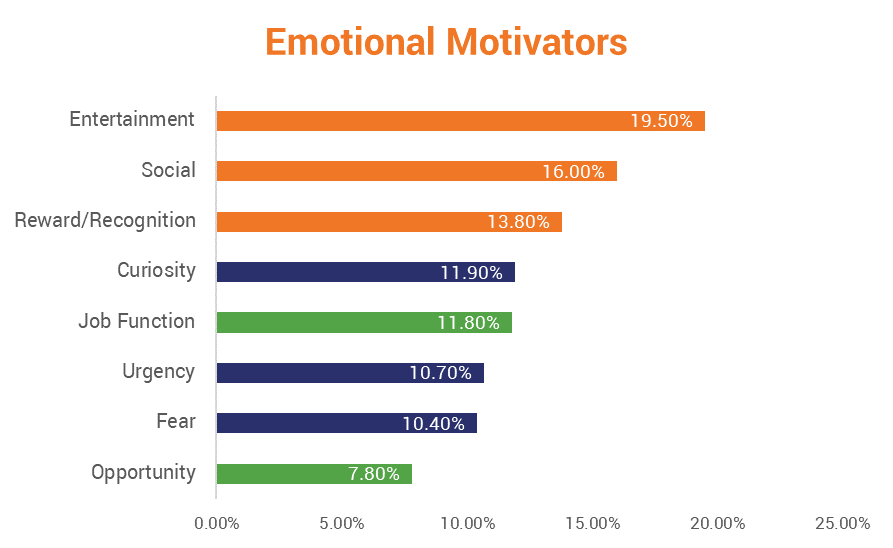
- Cybercriminals frequently impersonate trusted
brands. Cybercriminals love using the reputations of well-known and trusted
brands as part of their attacks. Impersonating a company such as PayPal,
Amazon, or even FedEx makes it easier to get a target to open and engage with their
phishing email. This is, in part, because the target has a certain expectation
of trust and safety from those brands.
Types of Phishing Attacks
When it comes to answering the question “what is
phishing,” it’s important to recognize that there are many types of phishing. Some
types of phishing are pretty generic in their approach while others are highly
targeted. You have the basic, old school “Nigerian Prince” email scams. You
know, the whole “Dear friend, I have millions of dollars that I need to protect,
and only you can help me do it!” spiel. Then you also have the more convincing
and planned types of phishing that are known as spear phishing or CEO fraud,
which are far more convincing and pose significant threats to your organization.
Here’s a hilarious variation of an old school spam-type
phishing email that was received by one of our customer experience team
members:
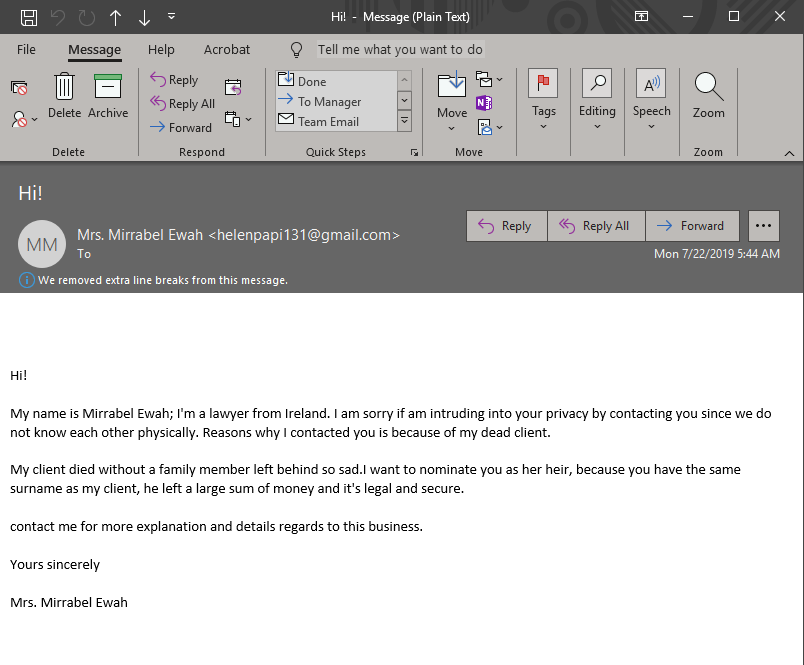
Wow… It looks like my colleague can retire early! Lucky
lady.
But, seriously, it’s hard to believe that someone is
going to fall for this type of obvious phishing. But we know somebody,
somewhere is because if cybercriminals had absolutely no success with these
types of messages, they wouldn’t bother sending them.
The list of common phishing attacks doesn’t end with just
spam-type messages and spear phishing. And phishing attacks are not limited to
emails alone. In fact, phishing can be conducted using a variety of
technologies, including telephones, text messages, websites, or even social
media accounts.
So, what are some of the most common types
of phishing attacks? We’ve already spoken about many of these types of
phishing in previous articles on Hashed Out, but we’ll rehash them here briefly
just to help remind you:
Business Email Compromise/CEO Fraud
A BEC or CEO fraud attack typically involves an attacker
imitating the company’s CEO or another high-level executive and sending emails to
lower-level employees directly with the goal of eliciting an intended reaction.
The goal could be to gain access to sensitive data or to get significant funds
via wire transfers.
Here’s a CEO fraud phishing email example that our office
manager recently received:

Clone Phishing
This type of phishing involves a cybercriminal using the
language, design, and “feel” of a legitimate message from a company and
creating a virtually identical, malicious version of it. For example, if
someone regularly receives legitimate package tracking emails from FedEx or
DHL, they’re not likely to closely study every email to see if there are any
discernible differences from the ones they previously received. They’re more
likely to simply skim the email or jump directly to clicking on the fake
tracking link. All it takes is one moment of unawareness — and that’s what
criminals are counting on.
Domain Spoofing
Much like how it sounds, domain spoofing occurs when a
hacker uses either fake emails or fraudulent websites and makes them look like
they’re legitimate. In the case of email, the criminal “spoofs” the emails to
make them look like they’re coming from the company’s legitimate domain. With
the website domain spoofing, they’ll adopt the legitimate website’s design and
use either a similar URL or use Unicode
characters to replace the ASCII characters in the domain.
Evil Twin
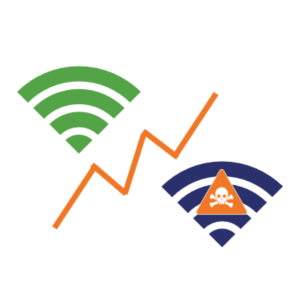
Unlike the other types of phishing that made this list,
an evil twin phishing attack is one that capitalizes on Wi-Fi. In this type of
phishing attack, cybercriminals are like spiders: They spin “webs” and wait for
their prey to come to them. They do this by creating a rogue Wi-Fi hotspot that
looks legitimate — even using set service identifiers (SSIDs) that are the same
as the real network — to trick users into connecting. This approach allows the
attacker to eavesdrop on their network traffic to gather personal and corporate
information without the victim being any the wiser.
HTTPS Phishing

This type of phishing is pretty basic — yet surprisingly
effective. We’ve previously written about how 58%
of all phishing websites are served via HTTPS. The trick to this type of
phishing method is that the criminal sends an email with only a
legitimate-looking link in the body — either in a clickable- or non-clickable
format.
So, why would anyone be foolish enough to click on such
an obvious phishing email? Because the attacker sends the message so that it
appears to come from a legitimate source — the target’s boss, family member,
friend, or even their CEO. It all comes back to the social engineering tactics
we mentioned earlier.
Smishing
Smishing stands for “SMS phishing.” In a nutshell, it’s a way for
cybercriminals using text messages that appear to come from legitimate sources to
lure users into downloading malicious payloads via malicious URLS. The links
could appear to be a coupon code from your favorite Mexican restaurant or even
free tickets to an upcoming show.
Spear Phishing
Spear phishing is the antithesis of old school spam
emails. Rather than blasting out emails to thousands of people in a massive
generic campaign, this type of scam involves a phisher researching their target
in depth. They often consult social media profiles and other publicly available
information — to socially engineer a convincing scenario. This information is
used to trick or compel the target into clicking on and engaging with the
email. The goal is to get them to provide information or perform a specific
action. Because these emails are so highly customized, they often can avoid
traditional spam filters.
Vishing
A vishing attack is simply the phone-based variant of
phishing, or what’s known as “voice phishing.” This type of attack occurs when
a criminal calls via phone and tries to get you to either provide personal
information or perform an action. Think of those notorious fake IRS phone calls
where they tell you that you owe X amount in taxes and threaten to have you
thrown in jail — a consequence you can avoid by simply making a “payment” using
pre-paid gift cards. Yeah, that sounds legit. Who knew Uncle Sam was such a big
fan of Amazon or iTunes?
Other forms of vishing include criminals pretending to be
your bank, credit card company, or even Marriott hotel and telling you that
you’ve won a free vacation — all they need is some personal information.
Watering Hole Phishing
This type of large-scale phishing attack targets
organizations by identifying specific websites that they frequently visit —
such as a vendor’s site — and infects one or more of those sites with malware.
In 2018, a watering
hole campaign compromised at least 21 major government and media websites
in Southeast Asia.
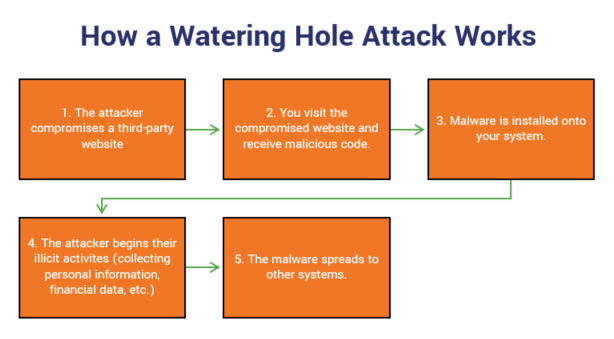
Whaling

In some ways, whaling is the lovechild of a spear
phishing attack and a quasi-CEO fraud attack. Don’t follow? Rather than
targeting low- to mid-level employees, whaling attacks target CEOs and other
high-level executives with spear-phishing attacks. This is sometimes done while
pretending to be a third-party company or by impersonating an executive at
another office within the targeted organization.
But what do virtually all of these types of phishing have
in common? They all use some type of technology, and many employ social
engineering tactics.
Here’s one example of a recent phishing email that
targeted one of The SSL Store’s vice presidents:
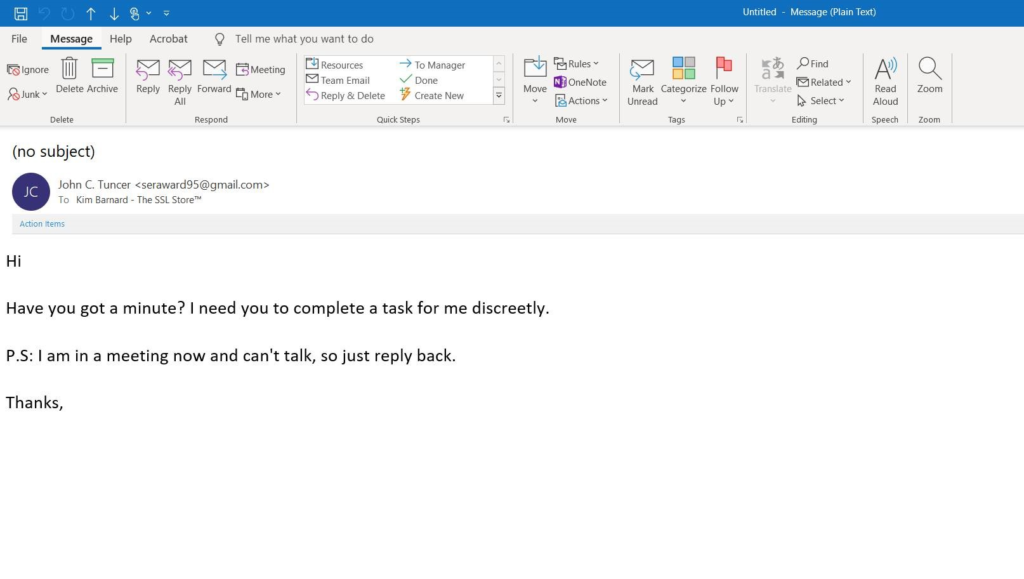
Who Are the Victims of Phishing?
Where phishing is concerned, there’s always more than one
victim. Victims include:
- the person or company being targeted,
- the company being imitated, and
- in phishing cases that result in the loss or
breach of employee or customer data, employees and customers are victims as
well.
Top 25 Most Commonly Impersonated Brands Used by Phishers
When phishers use the names and brands to trick their
victims, there are certain corporations they use more frequently than others. The
Q2 2019
Phishers’ Favorites report from Vade Secure shows that Microsoft tops the
list of the 25 most impersonated brands in phishing attacks. The list of the brands
most commonly impersonated in phishing is as follows:
- Microsoft
- PayPal
- Netflix
- Bank of America
- Apple
- CIBC
- Amazon
- DHL
- DocuSign
- Credit Agricole
- Dropbox
- Wells Fargo
- Chase
- Adobe
- AT&T
- Orange
- Alibaba
- Yahoo
- Stripe
- Societe Generale
- Comcast
- OVH
How to Keep Your Organization Safe
Suffice to say, after all this, that we’ve answered your
initial question, “what is phishing?” But now that you know what it is, how can
you prevent them from being successful? And how can you help prevent your own
organization and brand from being used by phishers to victimize others?
Unfortunately, there’s no one-size-fits-all solution when
it comes to email security and stopping phish. However, there are a variety of
best practices and multi-layered defenses you can implement to protect your
organization. Here are several methods and strategies you can use to arm
yourself in the war of email security:
Implement Regular Employee Awareness Training
Not to sound cruel or completely pessimistic, but the
thing that comes to mind is this unfortunate truth: There’s a sucker born every
minute, and some of them likely work for your company. This is why it’s
important to inform them through cyber awareness training.
Awareness training should cover multiple areas of
consideration, including:
- Learning how to “read” emails to identify spam,
phishing, and other malicious emails (looking for suspicious language, spelling
errors, reviewing the “from” field to ensure it’s the sender’s legitimate email
address, etc.). - Learning how to use email signing certificates
to sign and encrypt their emails; - Not responding to emotionally to emails (not
engaging with them out of curiosity or acting without forethought due to fear
or panic). - Taking the time to verify that the email came
from someone by contacting them directly through other communication channels
(take the time to call the person using an approved number or walk over to
their office to speak with them). - Instructing employees on how to react to phish by
not responding to the emails or clicking on any links or attachments, as well
as flagging the messages as spam.
This type of training, which should be held every three
to six months (ideally), should be mandatory for everyone with access to your
network and databases. This includes all full- and part-time employees
(including CEOs and other top-level executives), board members, and interns.
Create Security-Oriented Computer Use and BYOD Policies
Although it’s not ideal, it’s not uncommon for employees
to use their employer’s devices (laptops, iPads, smartphones, etc.) for
personal purposes such as checking their personal email and social media
accounts. This includes checking their email and social media accounts using
those devices. Or, your organization may even allow employees to bring their
own devices (BYOD). While this can initially save money in the short run, if
those devices are infected and are used to connect to your network or log in to
databases, you can face costly consequences in the long run in terms of data
breaches, ransomware, and security noncompliance fines.
Implement Effective Access Management Policies and Processes
One way to reduce the potential impact of phishing
attacks is to limit access to sensitive systems to those employees who actually
need access to do their jobs. Dave in accounting doesn’t need access IT
administrator access. And Sally in sales doesn’t need access to payroll or
personnel records.
In addition to ensuring that only the employees who have
access actually need it, periodically review the list to ensure that those
employees’ access needs have not changed. For example, if Paul in human
resources quits or is fired, deactivate his credentials and access immediately
to prevent him from having access to any sensitive data.
Use a Combination of Effective Email Protection Technologies
Truly savvy organizations use a multi-layered approach to
email security. We discuss several of these methods in our Email Security Best
Practices eBook, which was created as a resource to help protect you from phish
as well as keep you from being imitated in phishing emails that are sent to
others. We’ll briefly discuss them below, but for more in-depth information —
as well as information about how to implement them — you’ll want to check out
our eBook:
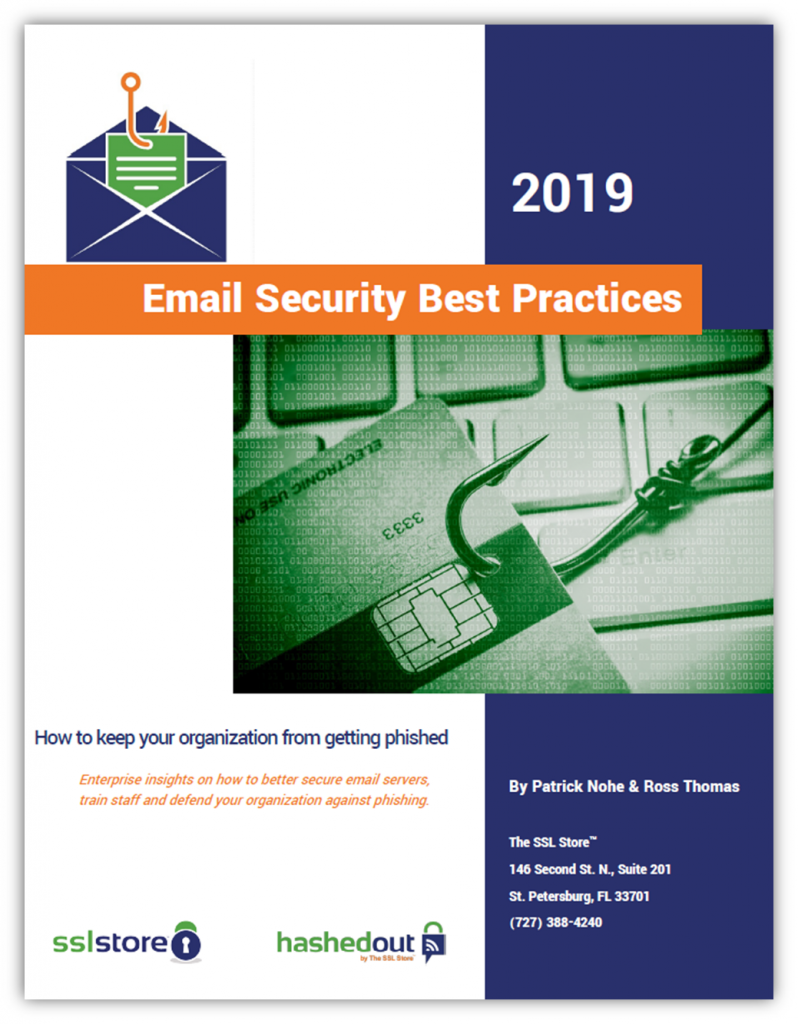
Don’t Get Phished.
Email is the most commonly exploited attack vector, costing organizations millions annually. And for SMBs, the damage can prove fatal: 60% fold within 6 months of falling victim to a cyber attack. Don’t be one of them.
Some of these technological methods to prevent being
phish and used in phish include:
- Blacklists and whitelists. Every
organization needs to maintain a living, breathing list of banned or approved
email addresses. Blacklists allow you to filter out harmful messages based on
their sender’s domain, email address, or IP address/range. Whitelists, on the
other hand, inform your servers and filters about which emails to allow through
using the same qualifying factors. - A secure email gateway (SEG). This is
typically an on-premises appliance or cloud service that intercepts emails and
filters them for spam, malware, and phishing. - Simple mail transfer protocol (SMTP). Want
to mitigate spoofing within your own organization? There’s a tool for that.
SMTP is frequently used by organizations to defend internal email from spoofing
by setting up custom rules in email clients. - Sender policy framework (SPF). This
protocol, referenced by a DNS entry, helps you to discern legitimate emails
from fake ones for emails you receive from regular contacts such as vendors. It
does this indicating whether an email from a sender’s IP address truly came
from the legitimate vendor’s network and not a different one. This means that so
long as an email is sent from an IP address in the DNS’ SPF record, it’ll be
allowed through. This is also useful for helping to prevent your own domain
from being used in copycat phishing emails by cybercriminals pretending to be
you. SPFs, which are ideal for smaller companies or organizations, work
hand-in-hand with DKIM. It’s important to note, however, that SPFs only work
with mail servers that check SPF records. - Domainkeys identified mail (DKIM). Much
like SPF, DKIM involves updating your DNS records; however, it includes the use
of a cryptographic key that signs and validates emails as legitimate (because
the signature shows they’re authorized to be sent by your server). Using SPFs
and DKIM together will also help you get the most out of the next tech
recommendation. - Domain-based message authentication,
reporting, and conformance (DMARC). This email authentication, policy, and
reporting protocol is used to help detect and mitigate proof and forged sender
addresses. There’s far more to DMARC than that. But without getting too much
into the weeds, the general idea is that having a strong DMARC reputation helps
to allow more of your legitimate emails to reach their intended recipients and
help them be less likely to fall for phish that imitate you. - Personal authentication certificates, or
S/MIME certificates. These certificates assert identity and help to enable
email encryption. S/MIME, which refers to secure/multipurpose internet mail
extensions, is a protocol that enables secure email by protecting the integrity
of the email data through at-rest and in-transit data encryption.
Final Thoughts
Having effective email security is no longer an option.
If you want to protect the reputation and standing of your organization, the
privacy of your employees’ and customers, and the integrity of your data, then
these are all steps that you need to implement now. Now that you know what
phishing is and how it works, there’s simply no excuse to do nothing.
Phishing attacks aren’t going to stop. Cybercriminals are
going to continue to use them until they’re no longer effective, and they move
on to using other tactics. The longer you wait to protect your organization
against phish, the more at risk your business will be to phishing attacks and
the associated risks that come with them.
*** This is a Security Bloggers Network syndicated blog from Hashed Out by The SSL Store™ authored by Casey Crane. Read the original post at: https://www.thesslstore.com/blog/gone-phishing/



